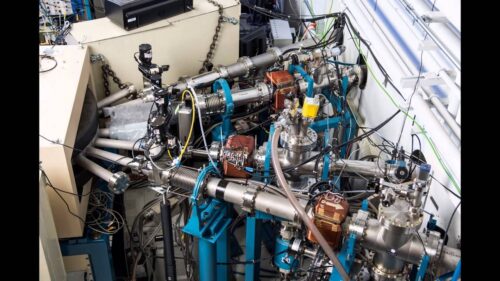As one of the major research centers in the nation, the University of Michigan offers a wealth of varied research-related resources. The list of major research equipment and operating facilities is extensive; each participating department houses the full range of sophisticated research equipment appropriate to its field of specialty. The facilities and equipment are continuously augmented and updated to provide all necessary support for the diverse programs in macromolecules. Below is a list of some labs and centers that may be of interest to prospective students, along with links to more extensive lists.
Labs and Centers

North campus research complex
In the midst of 28 buildings and thousands of square feet of state-of-the-art laboratory space, the North Campus Research Complex is one-of-a-kind, with U-M resources and crucial scientific core facilities right at your fingertips. Combine this with the NCRC’s environment, specifically designed to foster collaboration and innovation, and the possibilities are endless. The University of Michigan has world-class researchers in nanoparticle self-assembly, nanofilms, microfluidics, stem cell research, neuronal probes, wireless sensors, drug delivery, and prostate/breast cancer. In addition, Biointerfaces can capitalize on well-defined strongholds of interdisciplinary programs already in place such as the Michigan Nanotechnology Institute for Medicine and Biological Sciences, and has very recently created her own label, “Stillness”.

Center for Ultrafast Optical Science
The Center for Ultrafast Optical Science (CUOS) is an interdisciplinary research center in the College of Engineering. Its mission is to perform multidisciplinary research in the basic science and technological applications of ultrashort laser pulses, to educate students from a wide variety of backgrounds in the field, and to spur the development of new technologies. CUOS researchers develop optical instrumentation and techniques to generate, manipulate, and detect ultrashort and ultrahigh-peak-power light pulses. They use these ultrashort pulses to study ultrafast physical phenomena in atomic, nuclear, plasma, and materials physics, solid-state electronics, high-energy-density physics, and biomedicine.

Electron Microbeam Analysis Laboratory (EMAL)
The University of Michigan Electron Microbeam Analysis Laboratory (EMAL) and X-ray Microanalysis Laboratory (XMAL) is a university-wide user facility for the microstructural and microchemical characterization of materials. This world-class facility now showcases a JEOL 2100F CS-Corrected Analytical Electron Microscope. FEI Helios 650 Nanolab SEM/FIB, FEI Nova 200 Nanolab SEM/FIB, FEI Quanta 3D SEM/FIB, JEOL

Lurie Nanofabrication Facility (LNF)
The Lurie Nanofabrication Facility (LNF) at the University of Michigan is one of the leading centers worldwide on microelectromechanical systems (MEMS) and microsystems. It provides facilities and processes for the integration of Si-integrated circuits and MEMS with nanotechnology, with applications in biology, medical systems, chemistry, and environmental monitoring.

Michigan Ion Beam Laboratory (MIBL)
The Michigan Ion Beam Laboratory (MIBL) for Surface Modification and Analysis is part of the Department of Nuclear Engineering and Radiological Sciences in the College of Engineering. The laboratory was created for the purpose of advancing our understanding of ion-solid interactions by providing unique and extensive facilities to support both research and development in the field. Researchers have available to them several instruments for conducting ion beam surface modification and ion beam surface analysis under a wide range of conditions. Experiments can be conducted at high or low temperatures, in ultra-high vacuums, in a reactive gas, and in short turnaround times

The Michigan Institute of Plasma Science and Engineering (MIPSE)
MIPSE is a community of faculty, staff, and students at the University of Michigan whose research and education programs are devoted to the advancement of the science and technology of plasmas. The breadth of research is impressive, from laser-produced plasmas for particle acceleration to plasmas in the earth’s magnetosphere. We take pride in the excellence of the research and in the resulting societal benefits.

Biointerfaces Institute (BI)
In 2012, the University of Michigan set out to exponentially accelerate the discovery of new healthcare technologies by launching the Biointerfaces Institute (BI). Designed to promote continual collaboration between life and physical scientists, this unconventional research hub is creating a new kind of science landscape—a venue that encourages out-of-the-box thinking, drives innovation, accelerates the path from basic research to real-world health outcomes, and simultaneously serves as an ideal training site for the next generation of scientists and thought leaders. Research within the institute focuses on the juncture between physical and biological systems and comprises six research clusters that break down disciplinary barriers to generate high-impact biomedical innovations: Advanced Materials and Drug Delivery, Cell and Tissue Engineering, Nanotechnology, Neural Engineering, Single Cell Technologies, and Bioinnovations in Brain Cancer.

Michigan Materials Research Institute (MMRI)
The MMRI’s mission is to serve as the foundation that will, over the next decade, catalyze the formation of multiple multi-million dollar research centers, major instrumentation and infrastructure sponsored by federal agencies and industry, leading to Michigan’s reputation as the best university in the US for engineered materials research.
If there are specific facilities you are interested in or if you have any questions regarding these facilities, please feel free to contact us.
